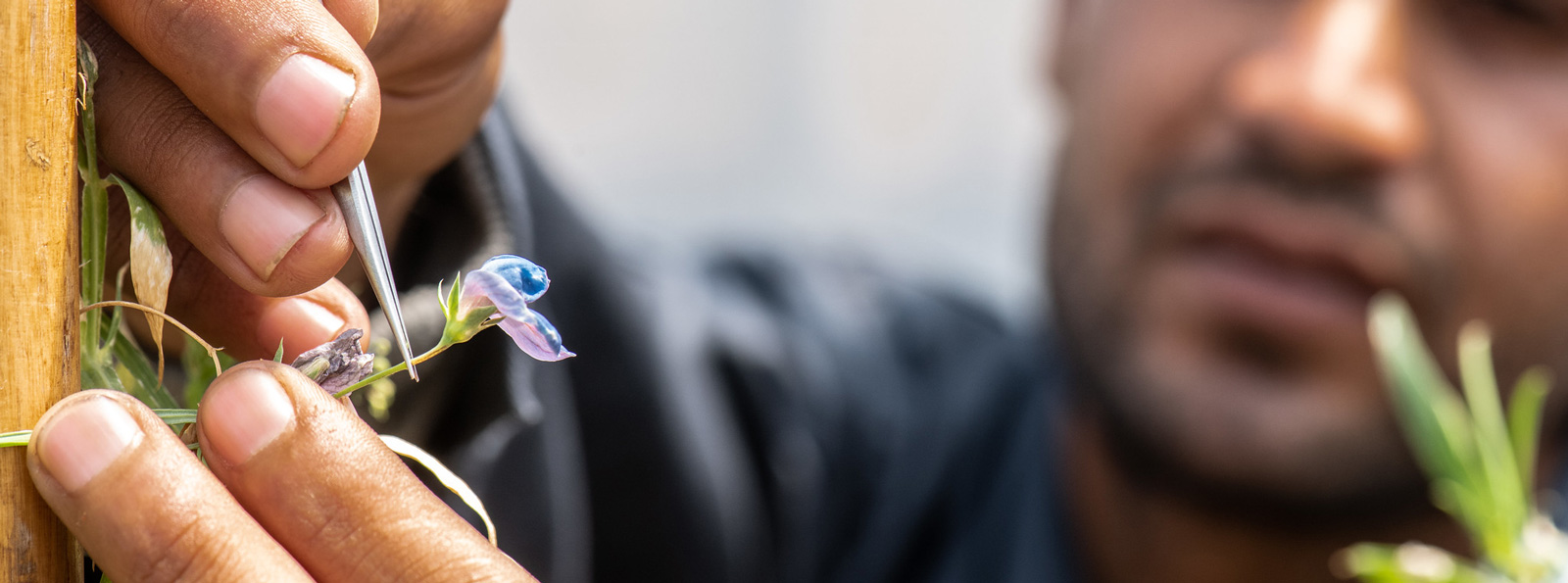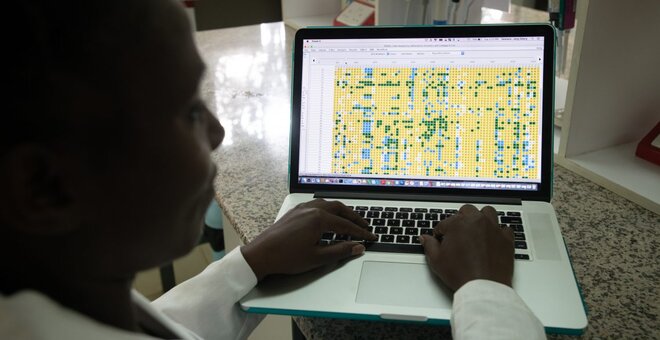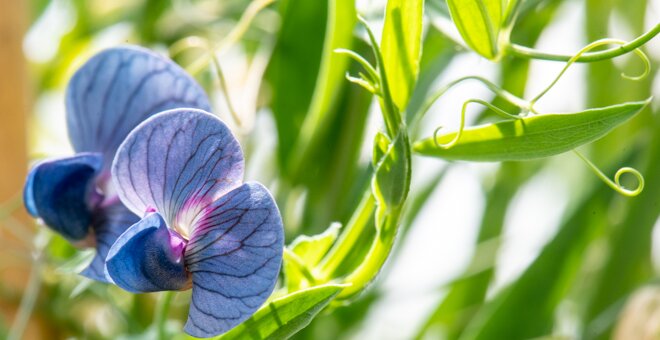Laying the foundations for better grasspea and finger millet
The Templeton Pre-Breeding Project
In 2022, the “Safeguarding crop diversity for food security: Pre-breeding complemented with Innovative Finance” Project entered its fourth and final year. Funded by Templeton World Charity Foundation, Inc., the Project is working to improve grasspea and finger millet. These food crops are prized for their nutritional value and ability to survive temperature extremes, drought and poor soil — but as the global climate changes, we need ever-better varieties.
The Templeton Pre-Breeding Project built on the Crop Trust’s Crop Wild Relatives (CWR) Project efforts. Scientists and breeders advanced CWR-derived materials and landraces of the two crops to develop new, more-nutritious, better-adapted and more-resilient varieties.
Templeton Project partners took that work to the next level by studying the genetic makeup of grasspea and finger millet, which in turn empowered the breeders to work much faster and more precisely.
The Project also explored innovative mechanisms for financing the conservation and study of crop diversity, providing valuable inputs to the Crop Trust’s future fundraising strategy.
At a glance
The Crop Trust–Templeton Pre-Breeding Project built on the Crop Wild Relatives Project, connecting plant breeders who are working on grasspea and finger millet with the genetic diversity they need to improve these crops found in their wild relatives. It also explored innovative avenues for growing the Crop Trust’s Endowment Fund. The Project was launched in 2019 and will conclude in January 2023.
PROJECT TITLE: Safeguarding crop diversity for food security: Pre-breeding complemented with Innovative Finance
HIGHLIGHTS FROM 2022:
Grasspea: Partners completed an analysis of the neurotoxin content of a diverse collection of grasspea samples. By the end of the year, some improved breeding lines were ready for large-scale evaluation in farmers' fields. Work in genomics helped identify the pathway leading to the development of ODAP, the neurotoxin involved. The Project also re-sequenced the genomes of 384 grasspea types to characterize their diversity to support marker-assisted selection.
Finger millet: In 2022, a coordinated regional finger millet breeding consortium in East Africa was created and germplasm was widely shared for conservation and use. Project partners identified diversity that is resilient to biotic and abiotic stresses. Numerous capacity-development activities and postgraduate trainings took place.
Financing: The Project’s review of innovative mechanisms for financing crop diversity conservation, including the Food Security Bond, blockchain and cryptocurrency, identified opportunities to strengthen fundraising inflows in support of the Crop Diversity Endowment Fund but noted the continued importance of traditional donors such as governments and foundations.
FUNDING PARTNER: Templeton World Charity Foundation, Inc.
IMPLEMENTING PARTNERS: International Center for Agricultural Research in the Dry Areas (ICARDA), International Crops Research Institute for the Semi-Arid Tropics (ICRISAT), Ethiopian Institute of Agricultural Research (EIAR), Kenya Agricultural and Livestock Research Organization (KALRO), Tanzania Agricultural Research Institute (TARI), National Semi-Arid Resources Research Institute of Uganda (NaSARRI), the John Innes Centre and the James Hutton Institute, UK.

Grasspea and finger millet are two “orphan crops” that have huge potential if given the research attention they so deserve. The Templeton Pre-Breeding Project gave us the resources we needed to demonstrate this. Our work has created the foundations on which we and others can build to add these crops to the arsenal of small-scale farmers, particularly in drought-affected areas.
Grasspea is grown in southern Asia, parts of sub-Saharan Africa and the Mediterranean region. It is easily cultivated and can withstand extreme environments, from drought to flooding.
It is grown both as feed for livestock and as a grain crop for humans. The crop is an excellent fodder, with reliable yield and high protein content.
However, it contains a neurotoxin that can cause paralysis in adults and brain damage in children if they consume too much of it — a common occurrence during famines. It is also susceptible to an aggressive parasitic weed known as broomrape. These two characteristics limit its usefulness in some farming systems.
Finger millet is a hardy crop that is well adapted to arid areas in Africa and Asia. Its small and tough grain is easily stored and it is a reliable food in times of drought and when other crops fail.
By providing all nine essential amino acids, finger millet is an important addition to the diets of people who rely mostly on crops such as cassava, maize and plantain, which are deficient in one or more of these key nutrients. The grains are ground and used in baking flatbread, preparing porridges and also for brewing beer. The straw is used as animal fodder.
It is susceptible to diseases such as blast and a parasitic weed called Striga and is relatively low yielding compared with maize and sorghum, largely because of lack of investments in breeding improved cultivars. This reduces its attractiveness to farmers. However, there is great potential for solving these problems, especially by using the diversity found in traditional landraces and wild relatives to breed for improved agronomic performance.
The space age comes to grasspea breeding
The foundation of modern breeding is a high-quality reference genome sequence. In order to obtain this for grasspea, in 2020 the Project re-sequenced and re-assembled the genome sequence of a well-known European grasspea line.
Using this essential resource, in 2022 Project partners identified the pathway that the plant uses to produce the neurotoxin that limits its usefulness as a crop. This has provided insights into the best approaches for developing varieties that produce substantially less toxin.
Building on the reference genome, the genomes of 354 diverse samples of grasspea and its wild relatives — the Lathyrus Global Diversity Collection (LGDC) — and of 30 crosses between a European and an Indian grasspea line were re-sequenced and analyzed. In 2022, this set of plants was grown at Terbol in Lebanon and Merchouch in Morocco so that researchers could collect data on several important traits, including neurotoxin levels.
These data are being used to develop molecular markers for key traits to speed up the breeding process.
There are other ways to accelerate progress in breeding. Speed breeding allows breeders to grow several generations of crops each year. It helps cut the time from making an initial cross to developing a new variety from as much as 12 years to only five or six years. A facility developed in Morocco has been used to speed up the breeding process for more than 250 crosses between grasspea varieties and wild relatives. The advanced crosses are being tested in the field.
Some of the lines with low neurotoxin content and high biomass have been multiplied for large-scale multi-environment testing with farmers in Bangladesh, India and Nepal. These will be done under the BOLD Project.
Better finger millet varieties are a giant step closer
Initial trials with finger millet lines derived from crosses with landraces identified 11 that performed well in Ethiopia, four that performed well in Tanzania and five that did so in Uganda. These have been promoted to national performance trials in farmers’ fields in the three countries. Another two promising lines yielded almost twice as much as local “check” varieties in preliminary testing in Tanzania and were selected for advanced field trials.
In support of the pre-breeding programs in these countries, in July 2022 the Project conducted a training course on molecular breeding techniques in Nairobi, Kenya. Eight participants — two each from Ethiopia, Kenya, Tanzania and Uganda — attended. The Project also supported four postgraduate students.
Sharing data and knowledge
All of the data generated by the Project has been uploaded to the publicly accessible Germinate Grasspea Database and the Germinate Finger Millet Database. The grasspea database includes information on more than 5,000 seed samples, 42,000 genetic markers and 58 traits, while the finger millet database includes information on more than 1,600 seed samples, 84,000 genetic markers and 51 traits.
The Project also provided virtual training on the tools it had developed. GridScore is an app to help keep track of data from field trials. Flapjack provides striking interactive visualizations of genotype data.
Innovative finance mechanisms
The Project also reviewed a broad range of financial instruments to strengthen fundraising inflows in support of the endowment — including the Food Security Bond, blockchain and cryptocurrency, crowdfunding and nature-based solutions.
The development of innovative finance instruments is a complex process. Initial ideas may appear to be less likely to materialize after further investigation, but they might open up discussions and contacts that enable the development of other lines of thought. Also, as the fundraising landscape continues to change, the list of high-priority opportunities and the best strategy to pursue are not static but require regular re-evaluation.
The results of the Project’s review suggests that opportunities exist for the Crop Trust in some of these areas, but that traditional fundraising from governments and foundations will continue to play an important role.
To support resource mobilization efforts in line with these results, the Crop Trust is finalizing an impact framework, developing targeted donor communication materials, hosting thematic roundtables with the private sector and further exploring engagement with emerging biodiversity reporting frameworks for businesses and the financial sector.
This Templeton funding has helped the Crop Trust to secure further funding to expand these activities via the GIZ/BMZ-funded project, Strategic Development of the Global Crop Diversity Trust, launched in 2021.
Related news
Accessible Software for Accessible Seeds
As any plant breeder and researcher will tell you, it’s all about the data. It’s the data that allows them to make smart choices about the crops they breed, speeding up the process of getting new varieties into farmers’ fields and...
25 May 2022
Pre-Breeding Work With Grasspea and Finger Millet Gets a Boost
Two food crops prized for their nutritional value and ability to survive temperature extremes, drought and poor soil are now receiving the attention they deserve. A new project led by the Crop Trust will help improve the...
2 Oct 2019
2 Oct 2019



